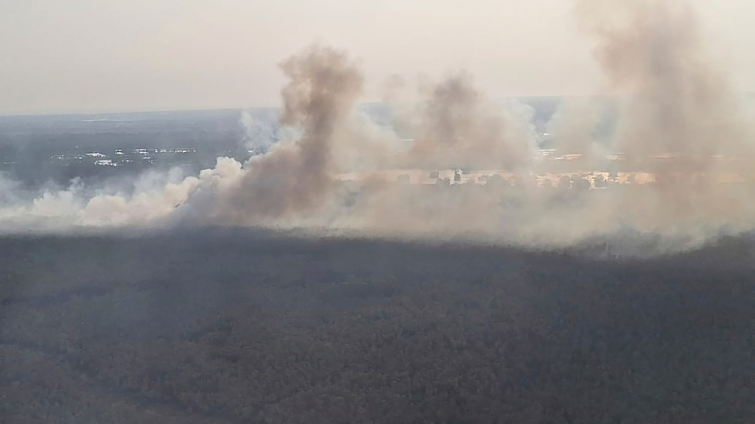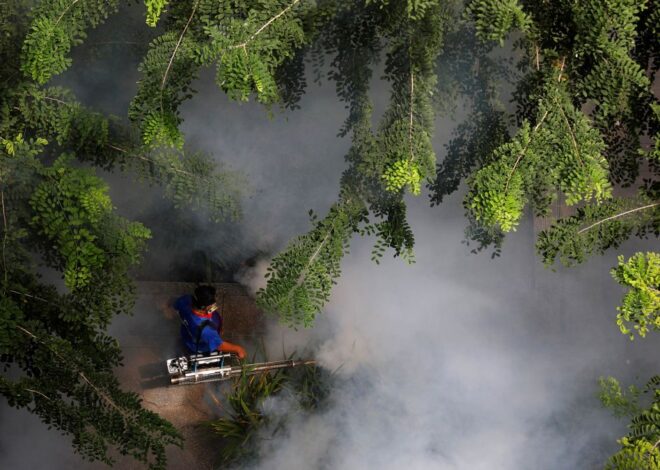
Indonesian Forest Fires Worsen Singapore’s Air Quality
Indonesian forest fires worsen Singapore’s air quality. Singaporeans were confronted with deteriorating air quality on Saturday as a consequence of the escalating forest fires in Indonesia. Official data revealed that at 2:00 PM local time, the 24-hour Pollutant Standards Index (PSI) in the eastern and central parts of Singapore exceeded 100. This level prompted advisories for the public to reduce prolonged outdoor activities.
Transboundary haze remains a recurrent problem in Southeast Asia, primarily due to regulatory gaps that hinder authorities from effectively curbing the practice of land clearance through slash-and-burn methods in Indonesia.
212 Hotspots Detected
Singapore’s National Environment Agency disclosed that Sumatra had 212 hotspots detected on Friday. This was a significant increase from 65 hotspots on Thursday and 15 the day before. The agency explained that a brief shift in wind direction on Friday evening caused some of the thin haze to blow towards Singapore, exacerbating the air quality in the island nation.
The main culprits behind these forest fires are often palm oil and paper pulp plantations in Indonesia. These entities frequently resort to traditional slash-and-burn techniques for land clearing. Interestingly, many of these companies are either domestically or foreign-owned, or they are registered abroad.
In efforts to combat these fires, the Indonesian government utilizes helicopters to spray water and employs cloud seeding techniques to induce rainfall, as stated by Environment Minister Siti Nurbaya on Friday. She dismissed the notion that the domestic haze impacts neighboring countries.
Malaysia Reached Unhealthy Levels
This week, Kuala Lumpur called upon Jakarta to address the fires within Indonesian territories, as air quality in Malaysia reached unhealthy levels.
The past decades have seen similar fires in Indonesia in both 2015 and 2019. These catastrophic events resulted in the scorching of millions of hectares of land and the spreading of haze to several Southeast Asian nations. Consequently, these fires generated record-high emissions, a fact confirmed by scientists.
It’s important to note that the most severe haze condition recorded in Singapore transpired in September 2015. During this episode, the 24-hour PSI exceeded 300, reaching hazardous levels. This situation led to the closure of schools in the city-state.
Singaporeans Brace for Deteriorating Air Quality
Singaporeans found themselves grappling with worsening air quality on Saturday, all thanks to the intensifying forest fires raging across Indonesia. The latest data revealed that by 2:00 PM local time, the 24-hour Pollutant Standards Index (PSI) for eastern and central Singapore had surpassed the 100 mark. This critical threshold prompted official advisories, cautioning the public to limit prolonged outdoor activities.
The issue of transboundary haze has persistently plagued Southeast Asia, mainly due to regulatory gaps that hinder authorities from effectively curbing land clearance practices involving slash-and-burn techniques in Indonesia.
Singapore’s National Environment Agency delivered a concerning report, indicating that Sumatra had a staggering 212 hotspots detected on Friday alone. This represented a stark increase from 65 hotspots identified on Thursday and a mere 15 on the preceding day. The agency noted that a brief shift in wind direction on Friday evening had pushed some of the thin haze towards Singapore, thereby further deteriorating the city-state’s air quality.
The Primary Contributors to these Forest Fires
The primary contributors to these forest fires are often palm oil and paper pulp plantations in Indonesia. These entities frequently resort to the traditional slash-and-burn method for land clearing. Interestingly, many of these companies are either domestically or foreign-owned, or they are registered abroad.
To combat these fires, the Indonesian government has deployed helicopters to spray water and employed cloud seeding techniques to induce rainfall, as announced by Environment Minister Siti Nurbaya on Friday. She categorically rejected the idea that domestic haze impacts neighboring countries.
This week, Kuala Lumpur implored Jakarta to take decisive action against fires occurring within Indonesian territories, particularly as air quality in Malaysia reached unhealthy levels.
Conclusion
The recent decades have witnessed similar devastating fires in Indonesia, notably in 2015 and 2019. During these episodes, millions of hectares of land were scorched, and the resulting haze engulfed several Southeast Asian nations. These calamitous events led to record-high emissions, a fact underscored by scientists.
It’s noteworthy that Singapore experienced its most severe haze condition in September 2015. During this period, the 24-hour PSI exceeded a staggering 300, pushing air quality to hazardous levels and ultimately prompting the closure of schools in the city-state.


